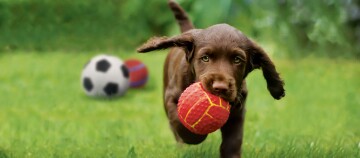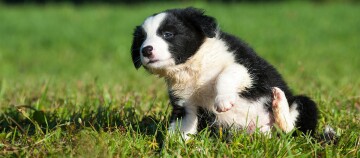Teething Puppy - Check Teeth Regularly and Support Your Pup During This Phase
03.01.2023 - Reading time: 3 minutes

Like all mammals, puppies eventually lose their milk teeth and their permanent teeth then come through. The change of teeth is usually relatively unproblematic in dogs, but a visit to the vet due to acute discomfort may occasionally be necessary. In any case, it is important to support your pup during this phase and to check its teeth regularly.
The puppy's bite and development
Dogs are born toothless, but from the third week the milk teeth come through. Puppies have 28 milk teeth. It has two canines, six molars and six incisors, which are located in both the upper and lower jaws. Depending on the breed, the dog retains these milk teeth until about three months of age. Then, over a period of about three months, the milk teeth fall out and the 42 teeth of the final set come through. In larger breeds of dog, the change of teeth usually takes place earlier than in smaller dogs.
How do I know that my puppy is teething?
If your little puppy suddenly starts nibbling on furniture, tugging at your clothes or chewing the sofa cushion after three months of age, this is also bad behaviour that should be reprimanded – but often these behaviours are also signs of a change of teeth, because the gums can become quite itchy at this time. The dog massages them by chewing on something. You can help your four-legged friend by providing it with chewing objects on which it can legitimately satisfy the chewing instinct – and at the same time protect your furniture. If you’re lucky, you’ll find a milk tooth on the floor or at the place they sleep that you can keep as a souvenir. Puppies often lick their teeth to loosen them and get rid of them. This is also a sign of the change of teeth.
Here’s what you should keep in mind when your dog’s teeth change
When your four-legged friend is teething, it is important for you to check their teeth regularly to see if everything is OK. Ideally, you should have already got your puppy used to you opening its mouth before it starts teething. Otherwise, now is a good time to do this, something that is essential for dental care, but also for visits to the vet. Signs that something has gone wrong in the transition from milk teeth to the final set of teeth include the puppy sleeping fitfully, refusing to eat or behaving in an unusually restless manner. In these cases, checking the bite will help you identify if the puppy is suffering from an infection and if its teeth are coming through correctly.
How to make teething easier for your puppy
Even though the change of teeth in a puppy is usually non-problematic, there are a few things you can do to help during this sometimes unpleasant phase. It is very important not to play tug-of-war with your puppy or encourage it to retrieve, as this can lead to pain or teeth being broken off by force. Instead, provide it with suitable chew toys, such as toys made of natural rubber. The change of teeth can be accompanied by inflammation and pain, so it helps to moisten dry food a little.
You should also make sure that your four-legged companion has an adequate supply of calcium, as this important bone building block promotes healthy teeth. However, high-quality puppy food usually contains enough of this. The change of teeth in dogs is not comparable to human children, but you can still help your animal family member by regularly checking their teeth.


